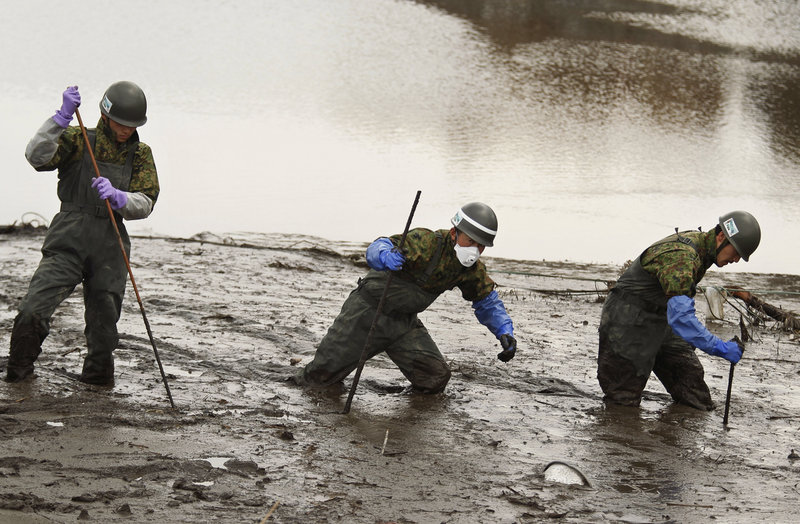SHICHIGAHAMAMACHI, Japan — A line of somber soldiers walked methodically through a drained swamp Monday, with each step sinking their slender poles into the muck beneath. If one hit a body, he would know.
“Bodies feel very distinctive,” said Michihiro Ose, a spokesman for the Japanese army’s 22nd infantry regiment.
The men were among 25,000 troops given the morbid duty of searching the rubble, the seas and the swamps of northeastern Japan for the bodies of the nearly 12,000 people still missing in last month’s earthquake and tsunami.
The two-day operation was the biggest military search since the March 11 disaster. With waters receding, officials hoped the troops, backed by police, coast guard and U.S. forces, would make significant progress. By Monday evening, they had found 38 bodies, the military said.
In the town of Shichigahamamachi, about two dozen Japanese soldiers in black boots, white masks and waterproof jumpsuits traveled silently in unison across the soggy earth, made even softer by torrential rains an hour earlier. In some areas, the mud came up to their knees.
The search focused on a long, narrow marsh drained in recent weeks by the army using special pump trucks.
Once the soldiers reached the end of the marsh, they turned around and walked back. And then back again.
“It’s important not to miss anything,” Ose said as he watched the soldiers nearly camouflaged by the dark gray mud. “As long as there is time left in the day, we will keep going up and down.”
In another part of town, several dozen soldiers cleared mountains of rubble by hand from a waterfront neighborhood filled with gutted and teetering houses. Four people in the neighborhood were missing, said 67-year-old Sannojo Watanabe.
“That was my house right there,” he said, pointing to a foundation with nothing atop it. He surveyed the neighborhood: “There’s nothing left here.”
A total of 24,800 soldiers – backed by 90 helicopters and planes – were sent to comb through the rubble for buried remains, while 50 boats and 100 navy divers searched the waters up to 12 miles off the coast to find those swept out to sea.
The search is far more difficult than that for earthquake victims, who would mostly be under rubble.
The tsunami could have left the victims anywhere. “We just don’t know where the bodies are,” Ose said.
More than 14,300 people have been confirmed dead and nearly 11,900 remain missing.
Send questions/comments to the editors.



Success. Please wait for the page to reload. If the page does not reload within 5 seconds, please refresh the page.
Enter your email and password to access comments.
Hi, to comment on stories you must . This profile is in addition to your subscription and website login.
Already have a commenting profile? .
Invalid username/password.
Please check your email to confirm and complete your registration.
Only subscribers are eligible to post comments. Please subscribe or login first for digital access. Here’s why.
Use the form below to reset your password. When you've submitted your account email, we will send an email with a reset code.